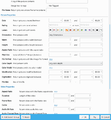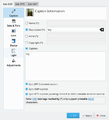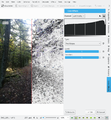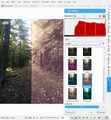Digikam/es: Difference between revisions
(Updating to match new version of source page) |
(Updating to match new version of source page) |
||
| Line 20: | Line 20: | ||
</gallery> | </gallery> | ||
== | ==The Image Editor== | ||
<gallery perrow="4"> | <gallery perrow="4"> | ||
Image: | Image:Digikam_metadata.png|Edit metadata | ||
Image:Digikam_rating.png| | Image:Digikam_rating.png|Assigning a Rating | ||
Image:Digikam_adjust_levels.png| | Image:Digikam_adjust_levels.png|Adjust Colour Levels | ||
Image:Digikam_white_balance.png| | Image:Digikam_white_balance.png|White Balance Adjustment | ||
Image:Digikam_b_w.png| | Image:Digikam_b_w.png|Convert to Black and White | ||
Image:Digikam_redeye.png| | Image:Digikam_redeye.png|Red-eye correction | ||
Image:Digikam_colorCorrection.png| | Image:Digikam_colorCorrection.png|Auto Colour Correction | ||
Image:digikam_lens_correct.png| | Image:digikam_lens_correct.png|Lens Auto Correction | ||
File:digikam_find_edges.png|Find Edges effect | |||
File:digikam_washout.png|Washout effect | |||
</gallery> | </gallery> | ||
| Line 103: | Line 105: | ||
I tested the installer with a Windows 7 machine, it worked like a charm. While the installer makes it supremely easy to deploy '''digiKam''' on '''Windows''', the application does have a few quirks. Most notably, the '''Windows''' version of '''digiKam''' cannot import photos directly from storage media or cameras, so you need to copy them to the hard disk using '''Windows’''' own built-in image transfer tool, and then add the transferred photos to '''digiKam'''. The ''Trash'' feature doesn’t work either, but you can work around this issue by deleting photos instead of sending them to the trash. To be fair, though, these issues are not caused by '''digiKam''' itself, but are due to bugs in the underlying KDE libraries which the application relies on." | I tested the installer with a Windows 7 machine, it worked like a charm. While the installer makes it supremely easy to deploy '''digiKam''' on '''Windows''', the application does have a few quirks. Most notably, the '''Windows''' version of '''digiKam''' cannot import photos directly from storage media or cameras, so you need to copy them to the hard disk using '''Windows’''' own built-in image transfer tool, and then add the transferred photos to '''digiKam'''. The ''Trash'' feature doesn’t work either, but you can work around this issue by deleting photos instead of sending them to the trash. To be fair, though, these issues are not caused by '''digiKam''' itself, but are due to bugs in the underlying KDE libraries which the application relies on." | ||
==Tutorials== | |||
There is a lot of tutorials about Digikam. The list is alphabeticaly sorted. | |||
* [[Special:myLanguage/Digikam/Adding Borders To Your Photos|Adding Borders To Your Photos]] | |||
* [[Special:myLanguage/Digikam/AddTextures|Add Textures]] | |||
* [[Special:myLanguage/Digikam/AspectRatios| Aspect Ratios]] | |||
* [[Special:myLanguage/Digikam/Assign Keyboard Shortcuts to Tags in digiKam|Assign Keyboard Shortcuts to Tags in digiKam]] | |||
* [[Special:myLanguage/Digikam/Basic RAW Processing|Basic RAW Processing]] | |||
* [[Special:myLanguage/Digikam/Batch Process|Batch Process]] | |||
* [[Special:myLanguage/Digikam/Batch Queue Manager and Script|Batch Queue Manager and Script]] | |||
* [[Special:myLanguage/Digikam/Black and White|Black and White]] | |||
* [[Special:myLanguage/Digikam/BleachBypassEffect|Bleach Bypass Effect]] | |||
* [[Special:myLanguage/Digikam/Calendars|Calendars]] | |||
* [[Special:myLanguage/Digikam/Calibrate and Profile Monitor|Calibrate and Profile Monitor]] | |||
* [[Special:myLanguage/Digikam/ChangeFormat|Change Format]] | |||
* [[Special:myLanguage/Digikam/Check Database|Check Database]] | |||
[[Category:Gráficos/es]] | [[Category:Gráficos/es]] | ||
[[Category:Fotografía/es]] | [[Category:Fotografía/es]] | ||
Revision as of 06:00, 8 January 2019
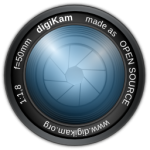 |
Ver, administrar, editar, mejorar, organizar, etiquetar y compartir fotos. |
DigiKam permite la importación de fotografías desde cámaras, creación de álbumes, etiquetado con fechas, temas y otras propiedades, y utilidades de búsqueda excelentes. Por favor, consulta el manual para ver todos los detalles, incluyendo los formatos de imágenes compatibles.
Administración de fotografías
-
Vista del álbum
-
Línea de tiempo
-
Viendo información Exif
-
Geolocalización
-
Búsquedas
-
Búsquedas detalladas
-
Identificación de duplicados
-
Búsqueda difusa
The Image Editor
-
Edit metadata
-
Assigning a Rating
-
Adjust Colour Levels
-
White Balance Adjustment
-
Convert to Black and White
-
Red-eye correction
-
Auto Colour Correction
-
Lens Auto Correction
-
Find Edges effect
-
Washout effect
La interfaz para cámaras
-
Lectura de medios extraíbles
-
o desde una cámara
-
Guardado directo a los álbumes
-
Añade geolocalización a fotos individuales
La mesa de luz
-
Comparar una serie de fotografías
-
Examinar detalles
-
Las puntuaciones hacen que elegir sea más fácil
-
Ver la configuración de la cámara
ShowFoto
Para aquellos que encuentren la interfaz de DigiKam demasiado técnica, ShowFoto da acceso a las misas herramientas, con una interfaz popular.
-
Navegación
-
Propiedades de la imagen
-
Ver propiedades de la imagen
-
Geolocalización de nuevo
-
Ampliaciones predefinidas
-
Histograma
-
Preferencias generales
-
Opciones de ayuda de herramientas
-
Opciones para imágenes Raw
-
Preferencias de gestión del color
-
Opciones de guardado de archivos
-
Configuración de una presentación
La página de ayuda del proyecto tiene enlaces a Preguntas más frecuentes (FAQs) y a los detalles para la suscripción a Listas de correo.
Hay un breve tutorial en vídeo aquí.
La sección sobre Gestión de recursos digitales ya no está disponible en las páginas web, aunque si lo está en el manual, que puede aparecer en tu distribución como digikam-doc, o que puedes descargar como un conjunto de archivos .pdf, digikam.pdf, showfoto.pdf and kipi-plugins.pdf
El blog Open Source Photo Processing Comes of Age de rm42 analiza el desarrollo desde la versión de KDE 3, y proporciona una visita guiada útil.
Tenemos una colección creciente de tutoriales que te ayudará a disfrutar más y a tener más productividad con digikam. La página de tutoriales de Digikam tiene un lista con un breve comentario sobre el contenido.
Useful digiKam Tricks
Transcribed from Dmitri Popov's blog, 26 September 2011
- To quickly adjust thumbnail size in the Album view, press and hold the Ctrl key, then use the mouse scroll wheel to make the thumbnails larger or smaller.
- With the feature enabled, digiKam automatically hides originals and displays the latest modified versions of the photos. For example, if you process a NEF file and save it in the JPEG format, digiKam hides the original RAW file and shows only the JPEG photo. To disable this feature, choose and make sure that the option in the In main view section is enabled. To keep things tidy, you can then group the original and all its versions. To do this, select the photos you want to group, right-click on the selection, and choose .
The trash has reached its maximum size! Cleanup the trash manually
If you receive this error message and emptying the Trash doesn’t help, then the following command may solve the problem:rm ~/.local/share/Trash/metadata
- Need to quickly locate all untagged photos? In digiKam, expand the left sidebar, and press the button. In the window, tick the check box and press to run the search.
- Instead of the conventional thumbnail view, digiKam lets you map your photos on a globe. Choose , and you should see photos from the current album mapped on the 3-D globe. You can then use the mouse to rotate the globe and the mouse wheel to zoom in and out. Obviously, the Map view displays only geotagged photos.
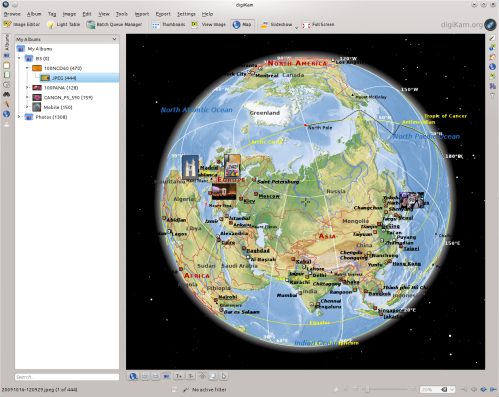
digiKam 2.2.0 Installer for Windows
In his blog of 22 October, 2011, Dmitri Popov writes:
"Good news for those who want to run the latest version of digiKam on Windows. The SourceForge repository now has a Windows installer of the latest digiKam version courtesy of Ananta Palani.
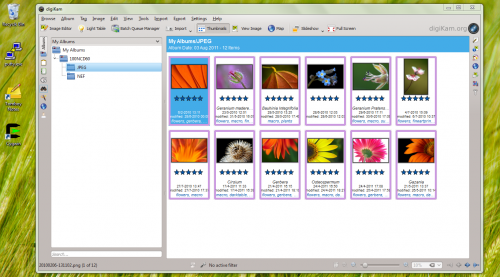
I tested the installer with a Windows 7 machine, it worked like a charm. While the installer makes it supremely easy to deploy digiKam on Windows, the application does have a few quirks. Most notably, the Windows version of digiKam cannot import photos directly from storage media or cameras, so you need to copy them to the hard disk using Windows’ own built-in image transfer tool, and then add the transferred photos to digiKam. The Trash feature doesn’t work either, but you can work around this issue by deleting photos instead of sending them to the trash. To be fair, though, these issues are not caused by digiKam itself, but are due to bugs in the underlying KDE libraries which the application relies on."
Tutorials
There is a lot of tutorials about Digikam. The list is alphabeticaly sorted.






